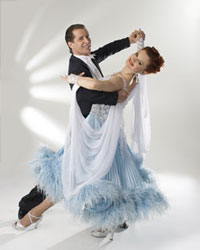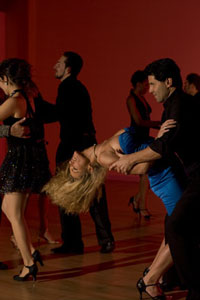A. American Style Smooth Dances:
 You will also hear these dances called the ‘Smooth’ dances. These dances move around the dance floor in a counter-clockwise fashion. These ballroom dances are elegant, beautiful, and dramatic, each with its characteristic style.
You will also hear these dances called the ‘Smooth’ dances. These dances move around the dance floor in a counter-clockwise fashion. These ballroom dances are elegant, beautiful, and dramatic, each with its characteristic style.
- Waltz: This is the granddaddy of all ballroom dances.
- Foxtrot: Foxtrot is the dance of Fred Astaire and Ginger Rogers.
- Tango (American Style): Oh what a fiery and dramatic dance!
- Viennese Waltz: This whirling, thrilling dance dates back to the early 1700’s in Europe.
B. American Latin Dances
These dances, also called ‘Rhythm’ dances, feature many of the sensual, romantic, sexy Latin dances as well as the quintessentially American East Coast Swing. The Latin dances are “spot” dances, meaning the couples generally dance in the same spot on the dance floor as opposed to traveling around the dance floor in a counterclockwise circle, (as they do in the Ballroom or Smooth dances.) Dances below are the dances we teach in our Ballroom/Latin series classes.
- Rumba: Rumba is universally recognized as the dance of love.
- Cha Cha: This is a fun, flirty dance that grew out of the Cuban Mambo, popular in the ’50’s in the U.S.
- East Coast Swing: This dance (and all contemporary Swing) has its roots with the Lindy Hop dances done at the great Savoy Ballroom in Harlem in the 1920’s and 1930’s.
- Bolero: Bolero is a slow, beautiful, expressive dance that is somewhat of a hybrid.
C. Club Dances
 These are dances that have their origins in night clubs and dance halls, as opposed to on the competition ballroom floor. The club dances often have a full community of dancers who dance only this dance. Each of these club dances has its own evolving culture, legendary dancers, and legendary musicians, as well as new and evolving styles and cultures.
These are dances that have their origins in night clubs and dance halls, as opposed to on the competition ballroom floor. The club dances often have a full community of dancers who dance only this dance. Each of these club dances has its own evolving culture, legendary dancers, and legendary musicians, as well as new and evolving styles and cultures.
- Salsa: This is a truly great club dance, one that is fun, accessible, sexy, and constantly evolving.
- Argentine Tango: This gorgeous and improvisational style of dancing has its origins in brothels.
- Hustle: The Hustle is the partner version of disco dancing.
- Night Club Two Step: This dance was allegedly invented by Buddy Schwimmer.
D. International Style Standard Dances
The International Style is primarily a competitive style of ballroom dancing. It shares many of the same dances with the American Style, but the International Style dances are more formalistic and difficult, with strict technique guidelines.
At Ballroom Dance Academy, we emphasize American Style ballroom dancing because it is much easier for students to learn and much more conducive to social dancing. That said, we do offer a few International Style classes in our Sunday Specialty Series. Here is a description of those dances.
D1. INTERNATIONAL STYLE STANDARD DANCES: These dances are the counterparts to the American Style Smooth dances. They travel around the ballroom along the line of dance. The Standard dances are:
- Waltz, Slow Foxtrot, Viennese Waltz, Tango. Much like American counterparts, but more difficult.
- Quickstep: The newcomer here is Quickstep, which is a fast, light, and elegant dance.
D2. INTERNATIONAL STYLE LATIN DANCES: These sexy dances feature loads of hip action, long expressive legs and arms, and long beautiful lines. The International Style Latin dances are Rumba, Cha Cha, Samba, Jive, and Paso Doble.
- Rumba and Cha Cha: Similar to its American Style counterparts featuring entirely different steps
- Jive is similar to a triple-step East Coast Swing.
- Paso Doble is a stirring and dramatic dance based on a Spanish bull fight.
